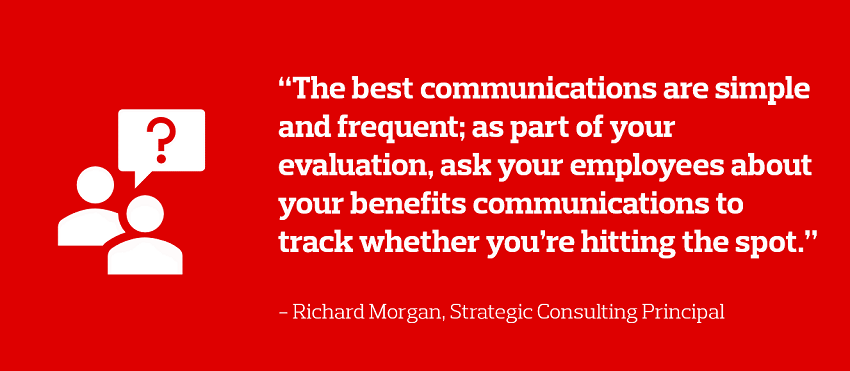Richard Morgan
July 2019

Futureproofing your employee benefits isn’t just beneficial for your employees – it’s also good for your business.
Ensuring that your benefits are suitable for your current workforce means that uptake is likely to be higher, and therefore your return on investment is greater. Employee benefits also form a significant part of the employee value position (EVP), and therefore can have a positive impact on talent retention and attraction.
1) Evaluate take-up
The first step in futureproofing your benefits offering is to evaluate current take-up.

Assessing the existing level of benefits engagement will provide a foundation on which you can build your future strategy. It might also highlight some quick win improvements which could be implemented before a wider roll-out.
2) Engage with your workforce
Our 2019 Benefits and Trends survey showed that just 62% of companies listen to employees about their needs. Let’s face it; your employees probably know what they want from their benefits more than you do. They might not know the specifics around the potential tax implications of life assurance or how much they need to save in their pension to maintain their current income at retirement, but they’ll definitely be able to tell you what kind of benefits they find valuable – or where your benefits offering is lacking.
You can also use this data to segment demographically, and plot benefit up-take around life events or stages. For example, you might find that employees who have recently become parents are more likely to utilise life assurance or savings schemes. You can then tailor your benefits communications accordingly.
3) Adopt a problem-centric strategy
Identifying problem areas will help you construct a plan to resolve them. If your organisation has a high absence rate, focusing on your health benefits might help mitigate absences. Evaluating take-up will show whether you need additional promotion, and employee surveys may show whether you need to add additional products to help facilitate employees looking after their health.
Again, it’s important to consider the demographics of your workforce. If you’re keen to improve employee engagement with the pension, look at salaries before stepping up your activity. If a large proportion earn less than £25,000, a workplace pension might not be a large part of their retirement income – and therefore may be less of a priority for these employees. Personal financial circumstances will also have an impact – if debt levels are high, employees may not want to make additional financial commitments.
4) Align with business plans
It’s sensible to align your benefits strategy with the wider long-term business plan.
Businesses evolve rapidly, and many – especially start-ups – may be unrecognisable from where they were five years ago. A prime example of this are banks; five years ago, one of the recruitment priorities was attracting part-timers to staff the branches. Nowadays, online banking has meant that banks are more likely to recruit tech-savvy employees – who may have very different benefit expectations.
5) Consider the macro-economics
Inevitably, the broader economic landscape will also have an impact on your employee benefits strategy. With the Office for Budget Responsibility expecting 600,000 more jobs by 2023, the UK falling birth rate and a reduction in immigration following Brexit, it’s likely that the future labour market will be tight.
In conjunction, the UK’s aging population means that more people are likely to stay in work beyond state pension age and that more people may find themselves providing care for elderly relatives. Reflecting these trends in your employee benefits will help keep you ahead of the curve in your recruitment and retention efforts.
6) Focus on engagement
An effective benefits strategy includes communication. You might find that your benefits are aligned with employee needs, but they’re simply not aware of what your company offers. Think of your benefits package as a product, your employees as the customer, and yourself as the marketing professional. Tailoring communications to different segments and at a relevant time – i.e. information on family health cover to those who have just returned from maternity or paternity leave – will increase the likelihood of engaging employees.

7) Undertake a competitor analysis
If you don’t know how your benefits compare against your competitors, your employees will. Benchmarking your offering against your peers can help you see any obvious gaps which might be pushing up staff turnover. However: don’t blindly follow them – their business could be headed in the opposite direction, or their employee demographics wildly different.
8) Consider legislative changes
Your futureproofing exercise should take potential changes in legislation and regulation into account. Although it’s not easy to predict what future costs you might be expected to meet – possibilities include higher pensions contributions and an increase in health and wellbeing benefits – it’s sensible to bear these potential costs in mind before allocating the budget elsewhere.
9) Be flexible
Futureproofing isn’t a commitment. Be flexible with your strategy; things inevitably change, so build in plenty of wriggle room in your strategy (and budget) so you can respond effectively to the unexpected. Some of the employee benefits of the future haven’t even been invented yet.

For more information or to discuss any of the issues outlined in this article, please get in touch by emailing us at letstalkbenefits@aon.co.uk or call us on 0344 573 0033.
Aon UK Limited is authorised and regulated by the Financial Conduct Authority. Registered in England and Wales. Registered number: 00210725. Registered Office: The Aon Centre, The Leadenhall Building, 122 Leadenhall Street, London EC3V 4AN.